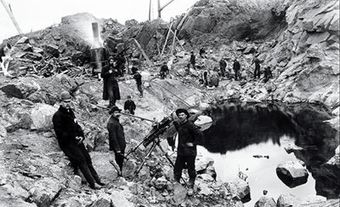
Limestone
Limestone is a SEDIMENTARY ROCK largely or wholly composed of calcium carbonate (CaCO3). Carbonate rocks, and in some cases marble, the metamorphosed near-equivalent of limestone, are important to the CONSTRUCTION INDUSTRY as building stone and aggregate, and as the primary component of portland CEMENT and lime. Limestones are also used in glass manufacture, as fillers, abrasives and soil conditioners, and in the manufacture of various chemicals. Quicklime is formed by the process of calcination, in which limestones are heated to the dissociation temperature of the carbonates (402-898°C), and held there long enough to release carbon dioxide. Although the term "lime" in some cases is used to refer to pulverized limestone, it refers more correctly to quicklime (burned lime) and its products, slaked or hydrated limes (Ca[OH]2). Dolomitic quicklime (CaOMg0) is produced from dolomitic limestone.Slaked lime is quicklime combined with water; this hydrated lime is then sized to meet customer specifications. Lime is used principally in the steel, pulp and paper and mining industries, where its chemical qualities are required as a flux (promoting ease of melting), for digesting liquors and as a neutralizing agent. Water and sewage treatment and removal of sulphur dioxide from smelter-stack gases and thermal power-plant emissions have recently become more important. The use of lime in construction (eg, in mortar and sand-lime bricks) has been greatly reduced in recent years.
Limestone is quarried in the Northwest Territories, British Columbia, Alberta, Manitoba, Ontario, Nova Scotia and Newfoundland. Lime plants have been established near industrial centres where reserves of suitable limestone are available and where major consumers are situated. Ontario and Québec produce over 70% of Canada's total lime. A high-bulk, low-cost commodity, lime is rarely shipped long distances because the raw material for its manufacture is often available. Calcining is done in kilns of various types, including traditional vertical or rotary types, or more recently developed rotary hearth, travelling grate, fluo-solid and inclined vibratory types. The high cost of energy has required inclusion of preheating facilities in new plants, and environmental regulations have necessitated incorporation of dust-collection equipment. Limestone production in 2000 was 84 960 000 t, valued at $518 430 000.

 Share on Facebook
Share on Facebook Share on X
Share on X Share by Email
Share by Email Share on Google Classroom
Share on Google Classroom

